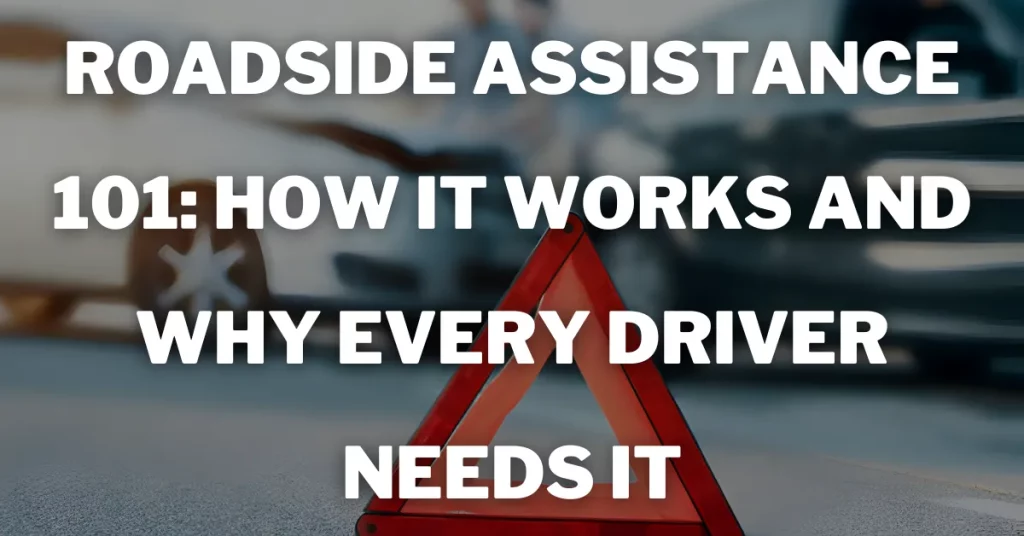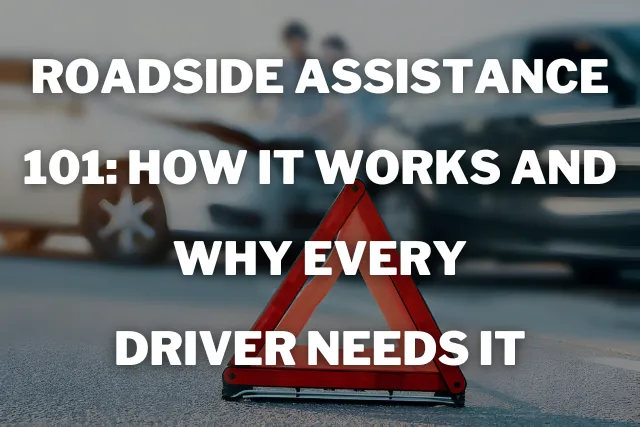
Roadside Assistance 101: Drivers who experience a breakdown or other issues with their vehicle while driving are offered roadside assistance 101.
Towing, replacing a flat tyre, jump-starting a battery that has died, delivering fuel when you run out of gas, and even unlocking the car if you’re locked out are typical services that are included. Car clubs, insurance companies, and even car manufacturers offer roadside help programs, usually as an add-on to an insurance policy or as part of a membership. Drivers can rest easy knowing that assistance is only a phone call away in the event of an emergency.
Importance of Roadside Assistance 101
Relaxed Mind: Whether drivers are travelling for business or pleasure, knowing that assistance is merely a call away gives them a sense of security. When travelling, having roadside help gives you peace of mind that you are addressed in case of emergency.
Emergency Relief: Roadside assistance 101 offers quick relief in the event that your car breaks down suddenly, keeping you from becoming stuck on the side of the highway.
Convenience: Handling a malfunction can be demanding and annoying, particularly if you’re pressed for time or far from home. By handling the issue quickly and causing the least amount of schedule inconvenience, roadside help provides convenience.
Safety: By offering assistance in potentially dangerous situations, such as tyre punctures, dead batteries, or getting locked out of your car, especially in unknown or dangerous places, roadside assistance 101 helps safeguard your safety.
What Does Roadside Assistance Exactly Offer
In the event of an emergency or breakdown, roadside assistance 101 services often provide a number of tools to aid drivers. These are a few typical characteristics of roadside assistance:
Service of Towing: Towing coverage is frequently included in the cost of roadside assistance. In the event that a car cannot be fixed on the spot, the service provider will make arrangements for it to be towed, at the driver’s request, to a repair facility or another place.
Flat Tyre Maintenance: Assistance changing a flat tire is a feature of many roadside assistance programs. A specialist will come to the scene and swap a punctured tyre with a spare if the driver is unable to change the tyre themself.
Oil Delivery: Roadside assistance 101 services frequently include gasoline delivery to the vehicle’s stranded position if a driver runs out of gas. The fuel itself is usually the driver’s responsibility, but the transportation service is paid for.
Lockout Facility: Roadside assistance101 plans frequently cover locksmith services in the event that a driver becomes locked out of their car. The car will be unlocked with the help of a specialist.
Jump-Start: Vehicles with batteries that are dead can receive jump-start help from roadside assistance organisations. When a technician arrives, they will jump-start the car and, if needed, check the battery.
Quick Repairs: To assist with getting the car back on the road, some roadside assistance 101 plans provide minor mechanical maintenance on the spot. This can involve maintenance procedures, including hose repairs, belt replacements, and other small mechanical repairs.
Battery Change: If a car’s battery dies and can’t be jump-started, certain roadside assistance 101 companies provide battery replacement services. The expert will immediately swap out the old battery for a new one.
Retrieval or Pulling: Roadside help might pay for the expense of winching or extrication services to liberate a trapped car or one that is unable to move on its own.
Benefits for Trip Interruption: Set plans include benefits for trip interruption that pay for costs like accommodation, food, and transportation if an incident happens a set distance from home.
Why We Need Roadside Assistance 101
There are various reasons why roadside help is needed:
Vehicle Breakdowns: Mechanical issues, punctures, dead batteries, and gasoline exhaustion are some of the reasons why cars can suddenly break down. In such cases, roadside assistance 101 offers quick support.
Protection: It can be risky to break down on the side of the road, particularly in isolated locations or in inclement weather. Roadside assistance 101 lowers the risk to passengers as well as the driver by guaranteeing that aid will arrive quickly.
Comfort: Having a car breakdown may be a stressful and inconvenient experience, particularly if it occurs far from home or in a strange place. Roadside service takes care of things so you can swiftly resume your drive.
Expertise: Roadside help providers are qualified individuals with the resources and know-how to effectively handle typical car issues. They can easily change a tyre, jump-start your car, and perform other required services.
Cost-efficiency: It might be costly to cover the full cost of specific services like tyre changes or towing out of pocket. Usually offered as a part of a club or insurance policy, roadside assistance programs provide these services at a much-reduced cost.
How Does Roadside Assistance Work
Services for roadside assistance 101 are available when a car breaks down or has technical issues while travelling. The general operation of roadside assistance 101 is as follows:
STEP 1: Make Contact
If a driver has a technical problem or breakdown, they can get in touch with the roadside help provider via phone, mobile app, or, if it’s accessible, the linked services on their car.
STEP 2: Give Information
The driver will have to give information about their location, the nature of the issue, and specifics about their car, such as its year, model, and licence plate number.
STEP 3: Navigation
When a vehicle runs out of petrol, the roadside help provider will send out a service truck that can handle a variety of problems, like towing, jump-starting a battery that has died, replacing a flat tyre, delivering gasoline, or doing small repairs to get the car running again.
STEP 4: Analyse and Evaluate
When the service truck arrives, the technician will evaluate the situation, offer any assistance that is required, and try, if at all feasible, to fix the issue right away.
STEP 5: Additional Benefits
In addition to the above-mentioned advantages, some roadside assistance programs also provide access to locksmith services in the event that the driver becomes locked out of the car, compensation for expenses incurred above-mentioned of the breakdown, and help with travel arrangements if the car cannot be promptly fixed.
STEP 6: Completion
Following the completion of the service, the driver can be requested to attest to the assistance received, and the supplier of services might get in touch with them again to make sure they were satisfied and to get their input on the whole experience.
Drivers must be aware of the precise coverage and restrictions of their roadside help package since different providers may have different terms and conditions and offer varying service levels.
Factors To Keep in Mind While Choosing the Right Roadside Assistance 101
To make sure the service fits their needs and offers dependable aid in an emergency, drivers need to take into account a number of things when selecting the finest roadside assistance 101 provider. The following important factors can assist drivers in selecting the best roadside assistance 101:
1. Coverage Alternatives: Examine the roadside help provider’s service offering. Examine the aspects that are important to you, including the number of service calls permitted annually, the towing distance, and coverage for various vehicles, to make sure the plan meets your demands and usage.
2. Providing access to Network Providers: Verify if the roadside assistance 101 company has a large network of approved service providers, including repair shops, towing firms, and locksmiths. More convenience and faster response times can result from having a large network.
3. Compatibility with Auto Insurance: Take into account how roadside assistance 101 fits into your current insurance plan if you’re thinking about adding it as an add-on to your auto insurance. Examine any possible overlaps or coverage gaps to ascertain the most economical choice.
4. Reaction Time: Seek out a supplier who has a history of prompt response times. In an emergency, getting help quickly can make a big difference, especially if you end up trapped in an unknown or dangerous area.
5. Availability: Verify that the roadside help service is available twenty-four hours a day, seven days a week. Since emergencies can happen at any time, it’s critical to have access to round-the-clock assistance.
6. Client Ratings and Image: Examine consumer comments and reviews on the roadside help company. Choose a service provider who has a track record of professionalism, dependability, and high-quality work.
7. Ease of Use: Take into account how easy it is to get and use the roadside assistance 101 service. Examine customer support and online resources offered by the supplier, including member portals and mobile applications, to make sure that obtaining support is a simple process.
Conclusion
To sum up, selecting the best roadside help service requires giving careful thought to a number of variables in order to make sure that the selected provider satisfies your unique requirements and provides dependable support during situations. It is imperative to assess the following factors: cost, extra features, coverage area, contract terms, convenience of use, network provider accessibility, reaction times, accessibility, customer reviews, and compatibility with motor insurance.
In the end, different drivers may have different needs when it comes to roadside help; this is because different drivers have different driving patterns, tastes, and geographic factors to take into account when choosing a provider. Through comprehensive investigation and evaluation of several roadside help choices, motorists may make an educated judgment and choose a service that provides comfort and consistent aid when it’s required.
FAQs:
Q1. What do you mean by roadside assistance?
A1. Automotive service providers offer roadside assistance as a means of helping drivers with typical vehicle-related problems. Lockouts, dead batteries, flat tires, and mechanical failures are a few examples of these problems.
Q2. Which services are usually covered by emergency roadside assistance?
A2. Roadside assistance packages frequently cover towing, fuel delivery, jump starts, aid with flat tires, lockout services, and small mechanical repairs.
Q3. How can I get help on the side of the road?
A3. The majority of roadside help companies have a hotline or a mobile app and provide 24/7 service. Be ready to share the specifics of your car, the problem’s type, and your location when you ask for help.
Q4. Are all kinds of automobiles eligible for roadside assistance?
A4. Most vehicle types, including automobiles, motorbikes, recreational vehicles, and even some commercial automobiles, can get roadside help. To be sure they can help with your kind of car, it’s crucial to confirm with the particular supplier.
Q5. Does my car insurance include roadside assistance?
A5. Roadside help is an optional add-on for some auto insurance plans. It’s crucial to check your insurance policy to find out if this coverage is included automatically or if you have to pay more for it.
Q6. Is it still possible to employ roadside assistance if the subscriber does not own the vehicle?
A6. Roadside assistance frequently only covers the car and not the driver. This implies that the person can ask for roadside assistance for the car as long as they have permission to drive it.
Q7. How can I pick the best company for roadside assistance?
A7. Think about things like the services provided, the coverage area, the response time, and feedback from consumers when selecting a roadside help provider. Comparing the costs, extra features, and limitations of the service plans is also crucial.

Swen Weber is a dedicated expert in towing services and roadside assistance, offering valuable information and top-notch services to ensure prompt and reliable solutions for drivers in need.


